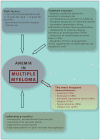New Biomarkers of Ferric Management in Multiple Myeloma and Kidney Disease-Associated Anemia
- PMID: 31683939
- PMCID: PMC6912471
- DOI: 10.3390/jcm8111828
New Biomarkers of Ferric Management in Multiple Myeloma and Kidney Disease-Associated Anemia
Abstract
Multiple myeloma (MM) is a malignancy of clonal plasma cells accounting for approximately 10% of haematological malignancies. MM mainly affects older patients, more often males and is more frequently seen in African Americans. The most frequent manifestations of MM are anaemia, osteolytic bone lesions, kidney failure and hypercalcemia. The anaemia develops secondary to suppression of erythropoiesis by cytokine networks, similarly to the mechanism of anaemia of chronic disease. The concomitant presence of kidney failure, especially chronic kidney disease (CKD) and MM per se, leading to anaemia of chronic disease (ACD) in combination, provoked us to pose the question about their reciprocal dependence and relationship with specific biomarkers; namely, soluble transferrin receptor (sTfR), growth differentiation factor 15 (GDF15), hepcidin 25 and zonulin. One or more of these are new biomarkers of ferric management may be utilized in the near future as prognostic predictors for patients with MM and kidney failure.
Keywords: anaemia; growth differentiation factor 15; hepcidin; kidney disease; mieloma multiple; soluble transferrin receptor; zonulin.
Conflict of interest statement
The authors declare that there is no conflict of interest regarding the publication of this paper. The funders had no role in the design of the study; in the collection, analyses, or interpretation of data; in the writing of the manuscript, or in the decision to publish the results.
Figures


References
-
- Jurczyszyn A., Skotnicki A. Multiple Myeloma. Comprehensive Diagnostics and Therapy. 1st ed. Wydawnictwo Medyczne; Wrocław, Poland: 2010.
-
- Lenihan D.J., Potluri R., Bhandari H., Ranjan S., Chen C. Evaluation of Cardiovascular Comorbidities Among Patients with Multiple Myeloma in the United States. Blood. 2016;128:4794. doi: 10.1182/blood.V128.22.4794.4794. - DOI
-
- National Registry of Malignancies: Multiple Myeloma and malignancies of plasma cells (C90) [(accessed on 29 September 2019)]; Available online: http://onkologia.org.pl/szpiczak-mnogi-nowotwory-komorek-plazmatycznych-...
Publication types
LinkOut - more resources
Full Text Sources

